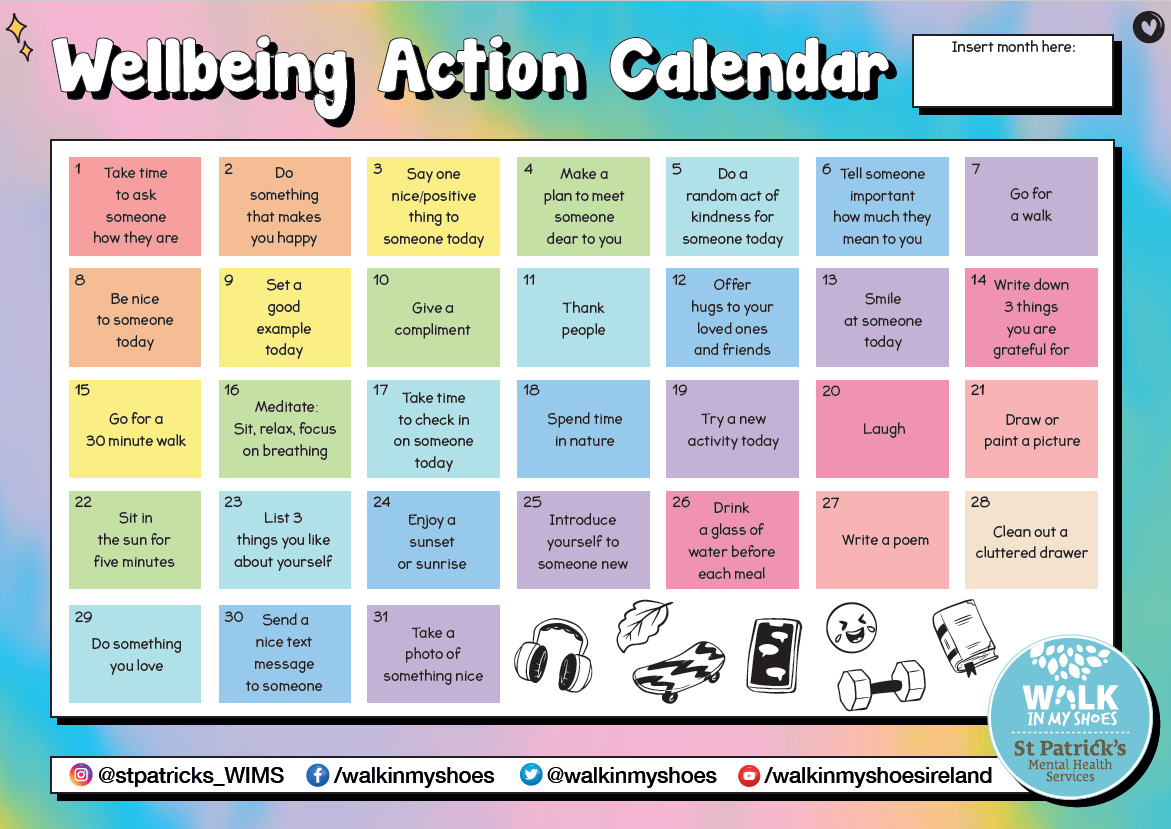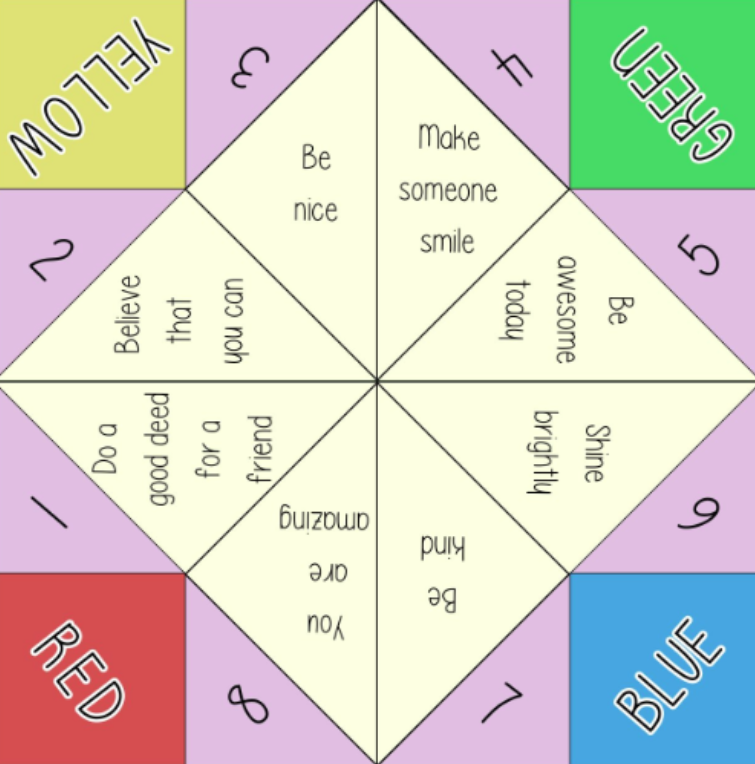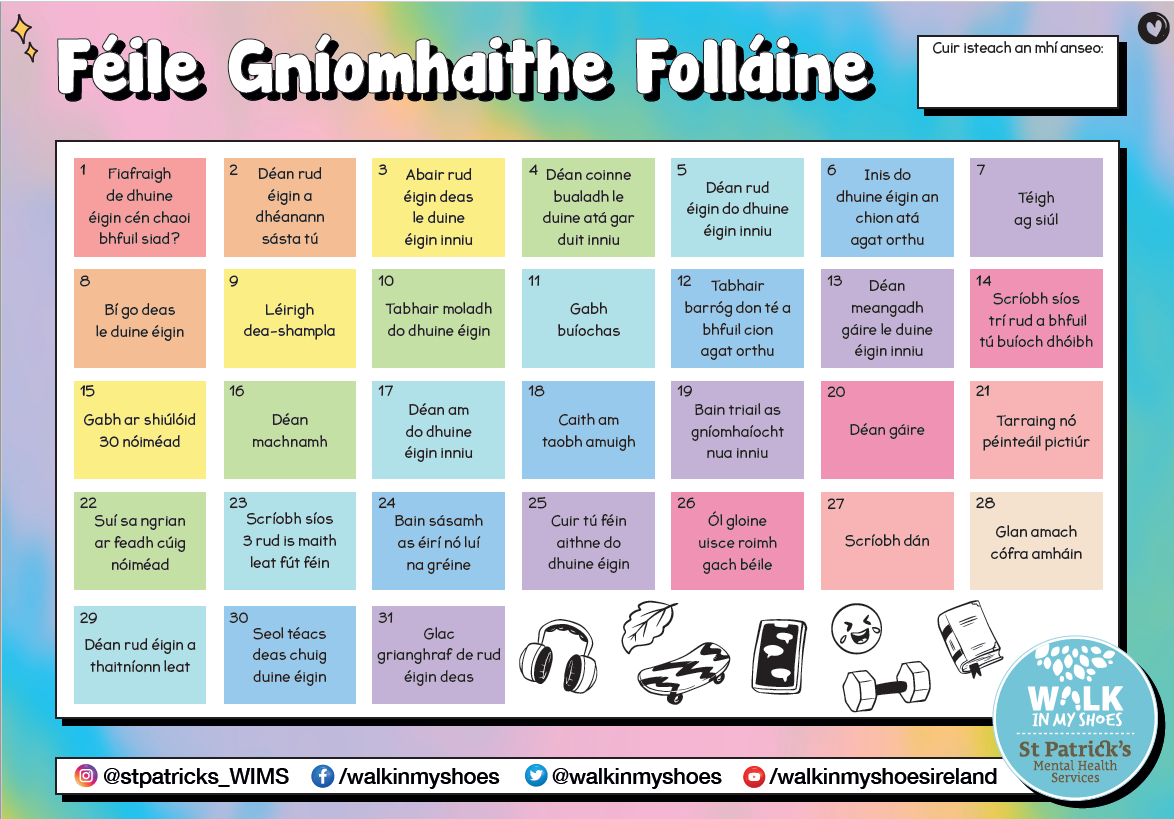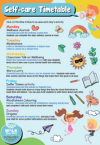Preparing for a mentally healthy life
Childhood and adolescence are exciting periods in life as young people discover and learn new things about themselves and the world they live in every day. It can also be a stressful time with many changes and different life experiences. Often, young people can experience high levels of stress, which may lead to feelings of anger and anxiety, low self-esteem, and depression.
There are many ways in which children and adolescents - with the help of their teachers, parents and guardians or a trusted adult - can tackle these feelings of stress, anger, and so on to ensure that they live as mentally healthy a life as possible. Our #MindYourSelfie resources can act as a source of support during these challenging times.
Teachers play a key role in the promotion of positive mental health for young people, and, through these resources, have the power to brighten up the classroom and their student’s self-esteem through a range of different activities and exercises. Teachers, if you would like to share your school activities to inspire other classrooms, or if you are seeking creative inspiration around school projects, you can access ideas for school presentations, posters, videos, event activities and more on our School Portal! Find out more and register for our School Portal here.
Parents and guardians can also use the activities and exercises at home with children and young people. These free tools are a great way to start and continue conversations around positive mental health and promote wellbeing activities in the home.
Enjoy our resources
Our free suite of resources includes:
- A series of guided relaxation audio exercises that introduces the practice of mindfulness to children
- Free eBooks designed to give practical tips and advice on mental health
- Printable mindfulness colouring sheets that can help students feel more relaxed
- Wellness Journals which provide young people with a template to record their feelings and thoughts
- A Wellness Action Calendar which suggests daily, positive actions students can take
- A Wellness Wall banner to create a space in classrooms or schools where everyone is welcome to read and contribute to a wellness wall
- A Selfie ‘Steem activity that invites students to share positive messages about one another
- A Selfie Tips Origami Chatterbox game that encourages children to think positively about themselves
- Our Frame of Mind film resource and teacher's companion guide which explores different mental health themes.
Minding Yourself, Minding Nature
Minding Yourself, Minding Nature is our nature workbook for secondary schools. Especially developed in partnership with BirdWatch Ireland, Leave No Trace and Biodiversity in Schools, the workbook explores the link between nature and mental health and offers lots of different nature-based activities for young people to try in school and at home.
The workbook, available in both English and Irish language versions, looks at why and how the natural world is important for our health and wellbeing. It suggests ways we can connect with nature in daily life to support our wellbeing. It also looks, in turn, at ways we can look after the natural world, and some of the reasons why this is important.
Worry Lorry
At times, we can all feel anxious or worried. There are things that children can do to help reduce that anxiety, like taking a few minutes for our Worry Lorry activity.
To get started, download and print the activity sheet. Then, encourage the young person to write down the things that make them worried or play on their mind on the lorry.
Ask them to think about the things that make them feel good and help their worries to disappear, and then share them with the second lorry driver below. Focus on these positive things as they colour in the rest of the sheet, and notice how their worries are driven away!

Wellbeing Action Calendar and Self-Care Timetable
Our mental health and wellbeing calendar suggests daily actions that children and young people can undertake to promote positive mental health and mindfulness. As it doesn't set dates or times, the calendar can be customised so that teachers, parents or young people have the flexibility to use it whenever suits your schedules. There are also English and Irish language versions available.
Our Self-Care Timetable for primary schools also shares a different wellbeing activity that children can do each day of the week to mind their wellbeing.
Mindfulness exercises
Our #MindYourSelfie series of guided relaxation audio exercises introduce mindfulness and meditation to children and young people. These exercises, which can be practiced in the classroom or at home, engage young people in body relaxation practices, which not only help to improve students' mindfulness, but also enhance their abilities to relieve tension built up in the body and mind.

Mindful Colouring
Mindfulness can improve our wellbeing. Our mindful colouring activities help children and young people to feel more relaxed by bringing their attention to the present moment as they focus on how to choose and apply colour in our specially-created designs.
Primary Schools
Get primary school colouring sheets below
Secondary Schools
Find secondary school colouring sheets here
Wellness Journals
Our Wellness Journals provide children and young people with a template to record their feelings and thoughts as a once-off assignment or as a daily activity.
Classroom presentations on mental health
We are a small team and while we would love to be able to come to individual schools to meet with children and young people to speak to them about the importance of positive mental health and wellbeing it is not something we are able to do. To spread a positive mental health message we developed two classroom presentations, hosted by Child and Adolescent Psychotherapist, Dr Colman Noctor, which are designed to educate students in primary and secondary school about how they can take care of their own mental health. The presentations give meaningful and practical ways that young people can look after their wellbeing. Topics covered include everything from building resilience and valuing our sense of self-worth, to understanding the relationships we have with ourselves and dealing with comparison culture.
Wellness Wall
The concept behind our Wellness Wall helps to promote positive, encouraging messages of wellness within schools. To get started, teachers can download the Wellness Wall banner below (or send us an email to request one) and check out our guides - also below - for details on how to use the banner in primary or secondary schools. The banner can be used to mark the chosen wall and create a space where everyone is welcome to read and contribute to it. Students and staff can be invited to write and share upbeat, helpful notes and messages of how they think wellness looks, sounds, and feels: the more creative, the better!
Film resource and companion guide
Our #FrameofMind film resource features clips from some of the shortlisted films in our Frame of Mind short film competition, which explore mental health themes affecting or important to young people. The film can be used to start a classroom discussion about mental health and wellbeing. The teacher’s companion guide has been developed to accompany the film and to share more information on the film's topics. It also provides questions and discussion points for a class. We recommend setting aside up to one hour for viewing this film and completing the exercises in the guide.

Selfie ‘Steem
Our Selfie 'Steem activity encourages students to share positive messages about and with one another. Each student writes their name or places their photo in the centre of the Selfie 'Steem sheet, which is then passed around the class. Other students then write positive messages about their classmates - such as that they are kind, caring, or fun to be around - on the sheet.
Teachers can even take the exercise a step further by asking students to write five things they like about themselves on the sheet before passing it around. The exercise shows how, even though we can think of lots of compliments for other people, it can be very hard to compliment ourselves; this helps teach students the importance of learning to be kind to themselves.
The exercise shows how, even though we can think of lots of compliments for other people, it can be very hard to compliment ourselves, thus teaching students the importance of learning to be kind to themselves.

Origami Chatterbox
How can you teach children to think positively about themselves?
One simple way is to start discussing the topic of positive thinking through a fun, simple game, like our Origami Chatterbox.
Start by inviting young people to fold the Origami Chatterbox.
To do this, they can follow instructions in the downloadable folding craft sheet. Once students have folded their Chatterbox, the game can begin.
Step 1 | Young people play in teams of two. The first person asks the other to pick a number. They then work the Chatterbox back and forth as they count to the number out loud.
Step 2 | The first person asks the second to pick one of the numbers on view inside the Chatterbox. Then, the first person works the Chatterbox back and forth again, counting to the number chosen by their friend.
Step 3 | The second person makes a final selection of one of the numbers on view inside the Chatterbox. The first person raises up the flap to reveal the positive message!
Step 4 | Start all over again - either with the same friend or someone else!
The exercise shows how, even though we can think of lots of compliments for other people, it can be very hard to compliment ourselves; this helps show the importance of learning to be kind to ourselves.














